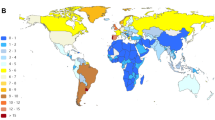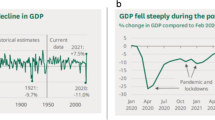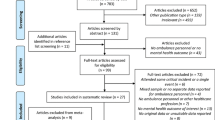Abstract
Objective
With the humanitarian work of the International Red Cross after the earthquake in Bam, Iran, it should be noted that international and national cooperation is possible according to recognised standards and concepts, and therefore morbidity records can be included uniformly in the context of day-to-day work even in post-disaster situations. The data ascertained show changes in the disease spectrum. Basic health provision according to the primary health care concept has priority in the post-disaster response (> 6 days) to the earthquake compared to more surgically oriented medical acute aid from abroad.
Material and methodology
In the international consensus conference at the beginning of January 2004, uniform morbidity recording was fixed to simple standardised disaster case definitions. The recording of traumatic, infectious and non-infectious diseases was carried out during the routine work in the outpatient facilities of the emergency response units of 3–31 January 2004. Examination was according to the following indicators: proportional morbidities and sum of the proportional morbidities.
Results and discussion
The complete examination time period included 16,677 new cases. The health facility rate only gradually increased. Temporal fluctuations in the numbers treated may be caused by secondary care of the injured, by a possible lack of accessibility (transport problems) or an increased acceptance of facilities. A written specification of the case definitions was not carried out in Bam, and so a comparison is not possible for recorded morbidities at the same time, and consistency cannot be reached for some of the data. Nine diagnoses/categories cover 98.68% of the consultations in the complete time period. Non-traumatic health problems predominate for the whole of the month. The category “others” is too high with 57.94%. Therefore, it may be assumed that certain diagnoses were overestimated, underestimated or not recognised. Vulnerable groups (children, women, the old) were not completely included.
Conclusion
Standards and guidelines for health care in humanitarian aid exist and are of help during planning, decision finding, execution and communication. Data acquisition instruments (registering books and patient files) should be developed and standardised by national and international humanitarian groups. The recording of morbidity is a simple instrument in the context of outpatient facilities and provides valuable information for further work during disasters.


Similar content being viewed by others
Abbreviations
- WHO:
-
World Health Organization
- UNHCR:
-
United Nations High Commission for Refugees
- ERU:
-
Emergency response unit
- NGO:
-
Non-governmental organisation
- MOHME:
-
Ministry of Health and Medical Education Iran
- IFRC:
-
International Federation of Red Cross and Red Crescent Societies
- REA:
-
Rapid epidemiological assessment
- PHC:
-
Primary health care
References
Abdallah S, Burnham G (2000) The Johns Hopkins and Red Cross/Red Crescent Public health guide for emergencies, 1st edn. Johns Hopkins University, Baltimore, pp 8–10
Ahmad K (2004) Iranian government draws up plans to rebuild Bam. Restoration of health-care facilities is a priority for the Iranian government and international aid agencies. Lancet 363:131
Akbari ME, Farshad AA, Asadi-Lari M (2004) The devastation of Bam: an overview of health issues 1 month after the earthquake. Public Health 118:403–408
Asadi-Lari M, Sayyari AA, Akbari ME (2004) Public health improvement in Iran—lessons from the last 20 years. Public Health 118:395–402
Bremer R (2003) Policy development in disaster preparedness and management: lessons learned from the January 2001 earthquake in Gujarat, India. Prehosp Disaster Med 18(4):372–384
Brennan R (2004) Question concerning data collection, via e-mail 05.09.2004, info@sphereproject.org
Colombo A (1997) Health information in emergencies: an overview of critical issues. The consequences of earthquakes on people’s health. In: Earthquakes and people’s health. WHO-OMS, Kobe, pp 268–279
Colombo S (2002) Health needs assessment in emergencies, p 8. www.who.int/disasters/sitrep.cfm. Accessed 28 Apr 2005
EarthTrends (2004) Population, health and human well-being. http://www.earthtrends.wri.org. Accessed 2 Apr 2005
EarthTrends (2005) Population, health and human well-being. http://www.earthtrends.wri.org. Accessed 1 Dec 2005
Griekspoor A, Collins S (2001) Raising standards in emergency relief: how useful are Sphere minimum standards for humanitarian assistance? BMJ 323(7315):740–742
IFRC (2004) Iran: Bam earthquake Revised Appeal No. 25/03 Operations Update No. 15. Special focus on reconstruction
MOH Iran (2004) Disease surveillance system in Bam. Center of Disease Management
Loretti A, Leus X, van Holsteijn B (2001) Relevant in times of turmoil: WHO and public health in unstable situations. Prehosp Disaster Med 16(4):184–191
Noji EK (1995) Disaster epidemiology and disease monitoring. J Med Syst 19(2):171–174
Noji EK (1997) The epidemiology of earthquakes: implications for vulnerability reduction, mitigation and relief. In: Earthquakes and people’s health. WHO-OMS, Kobe, pp 221–228
Noji EK, Toole MJ (1997) The historical development of public health responses to disaster. Disasters 21:366–376
Sphere Project (2004) Humanitarian charter and minimum standards in disaster response, 2nd edn. Oxfam, Oxford
WHO (2005) Communicable diseases control in emergencies: a field manual. http://www.who.int/infectious-diseasenews/IDdocs/whocds200527/. Accessed 25 Apr 2006
WHO (2004) Global atlas of infectious diseases. http://globalatlas.who.int/GlobalAtlas/. Accessed 2 Apr 2005
Conflict of interest statement
The authors confirm that there are no relevant associations that might pose a conflict of interest.
Author information
Authors and Affiliations
Corresponding author
Rights and permissions
About this article
Cite this article
Krieg, CM., Gardemann, J. A record of morbidity and medical request profiles in international humanitarian aid, taking the earthquake in Bam in Iran in 2003 as an example. J Public Health 17, 97–106 (2009). https://doi.org/10.1007/s10389-008-0230-9
Received:
Accepted:
Published:
Issue Date:
DOI: https://doi.org/10.1007/s10389-008-0230-9




